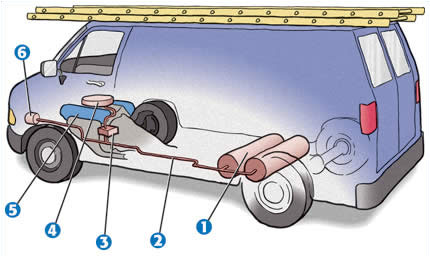Tell Me More Natural Gas Safety-SMART! Home
Natural Gas Vehicles
 Vehicles that run on natural gas instead of gasoline are called natural gas vehicles (NGVs). There are about 112,000 NGVs on our nation's roads today and over 13 million worldwide. More than 30 different manufacturers produce NGVs.
Vehicles that run on natural gas instead of gasoline are called natural gas vehicles (NGVs). There are about 112,000 NGVs on our nation's roads today and over 13 million worldwide. More than 30 different manufacturers produce NGVs.
Many passenger vehicles are available today that run on natural gas that has been compressed into special high-pressure cylinders to get more volume into a smaller amount of space (called compressed natural gas, or CNG). CNG is available at special fueling stations.
Some vehicles run on CNG only, and others can run on either CNG or gasoline; these are called bi-fuel vehicles. Some long-haul trucks and transit buses run on a different form of natural gas called liquefied natural gas, or LNG, which is made by refrigerating natural gas to condense it into a liquid.
The liquid form is much more dense than natural gas or CNG, and thus has much more energy for the amount of space it takes up. So, more energy can be stored in the same amount of space on a car or truck. That means LNG is good for large trucks that need to go a long distance before they stop for more fuel.
Here is how NGVs work:

- NGVs burn natural gas that is compressed and stored in cylinders.
- When the engine is started, natural gas flows into a fuel line.
- The gas then enters a regulator, where its pressure is reduced.
- The natural gas feeds into the engine through a fuel injection system where it's combined with air. The fuel-air mixture is adjusted to burn most efficiently and with the least possible emissions.
- Natural gas burns in the engine just like gasoline.
- NGVs can be refueled by attaching a hose at the fueling point.
NGVs are a popular transportation choice because they run cleaner than other vehicles. Compared to gasoline- or diesel-powered vehicles, they produce much lower levels of pollutants and cost less to maintain. Also, natural gas costs, on average, one-third less than conventional gasoline at the pump. The tanks used to store natural gas can withstand crashes and heat far better than most gasoline tanks can. In the event of a crash, natural gas disperses into the air, whereas gasoline pools on the ground, creating a fire hazard.



